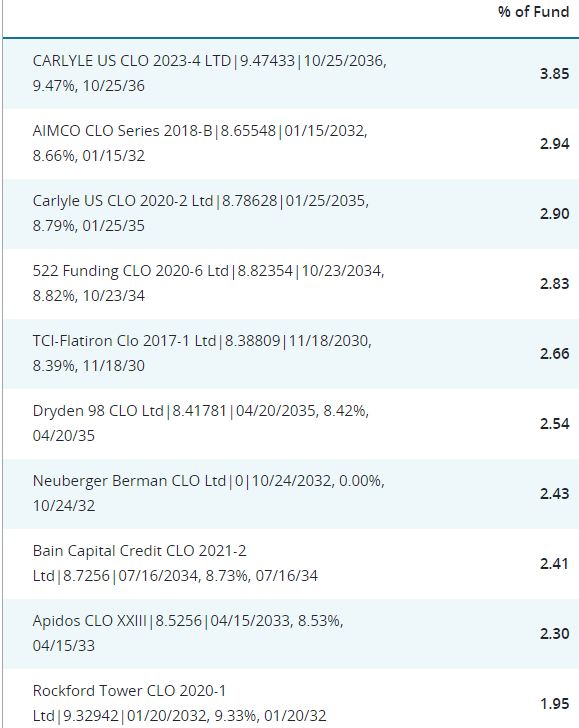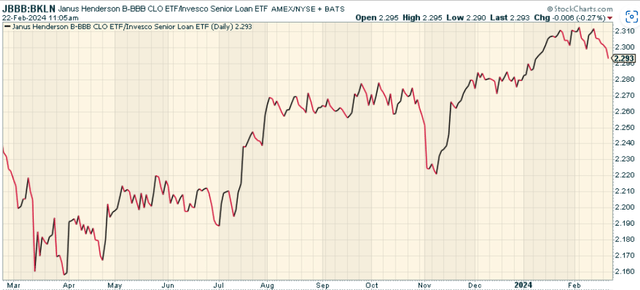Collateralized loan obligations don’t get much love from the media, but are worth considering in a portfolio. What are they? Floating-rate Collateralized Loan Obligations (CLOs) are complex financial instruments that consist of a pool of loans. These loans are typically senior, secured, non-investment grade loans issued by corporations. The pooled loans are securitized and structured into tranches with varying degrees of risk and return. The “floating-rate” aspect refers to the interest rates on these loans, which are not fixed but rather adjust in accordance with market interest rates, usually pegged to a benchmark such as the London Interbank Offered Rate (LIBOR) or its successor rates. This characteristic helps protect investors from interest rate fluctuations.
Investors in CLOs receive payments generated from the underlying loans’ interest and principal repayments, with the payments distributed according to the hierarchy of tranches, starting from the least risky to the most risky. Therefore, CLOs offer a way to invest in corporate debt with a mechanism in place to mitigate interest rate risk, albeit with a complex structure that carries its own set of risks.
One way to get access to CLOs is through the Janus Henderson B-BBB CLO ETF (BATS:JBBB). JBBB is an exchange-traded fund, or ETF, that provides exposure to floating-rate collateralized loan obligations generally rated between B and BBB, making the fund a unique investment opportunity for individuals and institutions alike. The ETF structure offers transparency, liquidity, and a lower cost, which were historically only accessible to institutional investors.
Dissecting the Fund’s Holdings
When we look at the holdings, no position makes up more than 3.85% of the fund. Total number of debt issues is 88, with an effective duration of -0.09. What this means is that the fund really isn’t sensitive to rates, and that this is ultimately from a risk perspective much more about credit.
janushenderson.com
With a net expense ratio of 0.51% this isn’t a terribly expensive fund for what you get. After all, you can’t exactly easily get access to CLOs as a retail investor, so it’s a good packaged product that gets you exposure. And given that this is debt, the yield is actually quite important here. The current 30-Day SEC Yield is 8.55%, with distributions done monthly. Nicely positive, with debt issues that have some credit risk but not a ton, and with duration not an issue for those worried about rising rates negatively impacting price.
Keep in mind that the sector composition and weightings of the Janus Henderson B-BBB CLO ETF are spread across several sectors, with the majority invested in the financial sector.
Comparing with Peer ETFs
When evaluating the performance of the Janus Henderson B-BBB CLO ETF, it’s crucial to consider its standing among peer ETFs. JBBB performs competitively in comparison to similar ETFs in the market like the Invesco Senior Loan ETF (BKLN). On a relative basis, JBBB has outperformed given the total return yield profile of the BBB securities it has and slightly negative duration, whereas BKLN has a positive duration, meaning that it’s been comparatively hurt with rising rates.
stockcharts.com
Weighing the Pros and Cons
Investing in the Janus Henderson B-BBB CLO ETF comes with its own set of pros and cons. The fund offers diversification potential and floating rate exposure, which are attractive features for many investors. However, it’s vital to note that the fund’s focus on B to BBB-rated CLOs can expose investors to higher credit risk compared to investment-grade securities. In addition, if you believe the next move is a rate cut, you may want fixed income that has duration to benefit from that cycle to come given the potential for price appreciation separate from yield driving total return.
Conclusion: To Invest or Not to Invest?
Investing in the Janus Henderson B-BBB CLO ETF can be a strategic move for those seeking exposure to floating-rate collateralized loan obligations. It’s a good fund, has gotten some traction from investors since inception, offers a different flavor of debt investing, and provide a high yield. It’s worth considering against bonds in your portfolio.
Read the full article here
